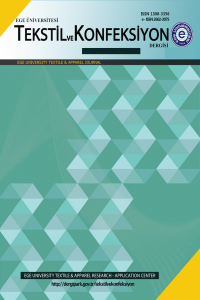TEKRARLI YIKAMANIN FARKLI ÜRETİM PARAMETRELERİYLE ÜRETİLMİŞ İĞNELENMİŞ VE KALENDERLENMİŞ DOKUSUZ YÜZEY TEMİZLİK BEZLERİNİN ÖZELLİKLERİNE ETKİSİ
Dokusuz yüzey, temizlik bezi, tekrarlı yıkama, aşınma dayanımı, fonksiyonel özellikler
THE EFFECT OF REPEATED LAUNDERING ON PROPERTIES OF NEEDLED AND CALENDERED NONWOVEN CLEANING MATERIALS PRODUCED WITH DIFFERENT PROCESS CONDITIONS
Nonwoven, cleaning cloth/wipe, repeated washing, abrasion resistance, functional properties,
___
- 1. EDANA 2012 Nonwoven Production Statistics, www.edana.org, 2015.
- 2. Batra S. K. and Pourdeyhimi B., 2012, “Introduction to Nonwovens Technology”, Destech Publications, USA.
- 3. Dharmadhikary R. K., Gilmore T. F., Davis H. A., & Batra S. K., 1995, “Thermal Bonding of Nonwoven Fabrics”, The Textile Institute, Textile Progress, 26(2), New York.
- 4. Desai A.N., Balasubramanian N. 1994, “Critical Factors Affecting the Properties of Thermal-Bonded Nonwovens with Special Reference to Cellulosic Fibres”, Indian Journal of Fibre&Textile Research, Vol: 19, pp: 209-215.
- 5. Onal L., Candan C., 2003, “Contribution of Fabric Characteristics and Laundering to Shrinkage of Weft Knitted Fabrics”, Textile Research Journal, Vol: 73(3), pp: 187-191.
- 6. Can,Y., Akaydın M., 2013, “Effects of Laundering Process on Abrasion and Wrinkle Resistance of Cotton Plain Fabric”, Tekstil ve Konfeksiyon, Vol: 23(1), pp: 49-54.
- 7. Duru S. C., Candan C., 2012, “Effect of Repeated Laundering on Wicking and Drying Properties of Fabrics of Seamless Garments”, Textile Research Journal, Vol: 83(6), pp: 41-55.
- 8. Değirmenci Z., Çelik N., 2014, “An Investigation on the Influence of Laundering on the Dimensional Stability of the Denim-Like Knitted Fabrics”, Tekstil ve Konfeksiyon, Vol: 24(4), pp: 363-370.
- 9. Anand S. C., Brown K. S. M., Higgins L. G., Holmes D. A., Hall M. E. and Conrad D., 2002, “Effect of Laundering on the Dimensional Stability and Distortion of Knitted Fabrics”, AUTEX Research Journal, Vol: 2(2), pp: 85-100.
- 10. Palamutçu S., Keskin R., Şengül M., Devrent N., İkiz Y., Hasçelik B., “Physical Properties of Antibacterial Treated Cotton Fabrics and Effect of Laundry Cycle”, Annals of The University of Oradea Fascicle of Textiles, Leatherwork, pp: 79-82, http://textile.webhost.uoradea.ro/Annals/Vol%20XV-no%20I/Art.%20nr.%2015,%20pag%2079-82.pdf ,
- 11. Lau L., Fan J., Siu T., Siu L. Y. C., 2002, “Effects of Repeated Laundering on the Performance of Garments with Wrinkle-Free Treatment”, Textile Research Journal, Vol: 72(10), pp: 931-937.
- 12. Kwon Y. A., Sarmadi A. M., 1995, “Wettability of Nonwoven Fabrics: Effect of Laundering on Water Absorption”, Clothing and Textiles Research Journal, Vol: 13(1), pp: 17-28.
- 13. Sawhney P., Reynolds M., Allen C., Slopek R., Nam S., Condon B., 2012, “Effect of Laundering Hydroentangled Cotton Nonwoven Fabrics”, Journal of Engineered Fibers and Fabrics, Vol: 7(3), pp: 103-110.
- 14. Çinçik E., Yıldız S. C., Yıldırım Ö., The Influence of Repeated Washing on Abrasion Resistance of Nonwoven Cleaning Materials/Cloths/Wipes Produced with Different Process Conditions, The Fiber Society’s Spring 2016 Conference: Textile Innovations-Opportunities and Challenges, University of Haute Alsace, 25-27 May 2016, Mulhouse/France.
- 15. AATCC TM-135-2000: Standard test method for determining dimensional changes in automatic home laundering of fabrics.
- 16. NWSP 130.1: Standard test method for determining mass per unit area of nonwovens, INDA&EDANA Worldwide Strategic Partners, 2012.
- 17. NWSP 120.1: Standard test method for determining thickness of nonwovens, INDA&EDANA Worldwide Strategic Partners, 2012.
- 18. Cincik E., Günaydın E., 2016, “The Influence of Calendering Parameters on Performance Properties of Needle-Punched Nonwoven Cleaning Materials Including r-PET Fiber”, The Journal of the Textile Institute, Vol ,. (in press).
- 19. NWSP 20.5: Standard test method for determining abrasion resistance of nonwoven fabrics using a nonwoven modified martindale abrasion, INDA&EDANA Worldwide Strategic Partners, 2012.
- 20. NWSP 30.1: Standard test method for determining hydraulic bursting strength of nonwoven materials-motor driven diaphragm bursting strength tester method, INDA&EDANA Worldwide Strategic Partners, 2012.
- 21. NWSP 10.1: Standard test method for determining nonwoven absorption, INDA&EDANA Worldwide Strategic Partners, 2012.
- 22. Koç. E. Çinçik E., 2013, “An Analysis on Abrasion Resistance of Polyester-/Viscose-Blended Needle-Punched Nonwovens”, The Journal of The Textile Institute, Vol: 104(8), pp: 852-860.
- ISSN: 1300-3356
- Yayın Aralığı: Yılda 4 Sayı
- Başlangıç: 1991
- Yayıncı: Ege Üniversitesi
DOKUMA KUMAŞ ÖZELLİKLERİNİN YAPAY SİNİR AĞLARI İLE TAHMİN EDİLMESİ ÜZERİNE BİR ARAŞTIRMA
Emel ÇİNÇİK, S. Cansu YILDIZ, Özge YILDIRIM
TÜRK MİNYATÜR KADIN GİYSİ FORMLARININ İYİLEŞTİRİLMESİ
COMPARISON OF SPECTROPHOTOMETRIC AND DIGIEYE COLOUR MEASUREMENTS OF WOVEN FABRICS
Małgorzata MATUSİAK, Anetta WALAWSKA, Wioletta SYBİLSKA
MODA TASARIMI EĞİTİMİNDE GİYSİ YAPISINI ANLAYARAK YARATICILIĞI GELİŞTİRMEYE YÖNELİK BİR YAKLAŞIM
KANCALI DOKUMA MAKİNASINDA KENAR TELEFİ UZUNLUĞUNUN GÖRÜNTÜ ANALİZ TEKNİĞİYLE İNCELENMESİ
Rafet AKDENİZ, H. Ziya ÖZEK, Göktekin DURUSOY
FAZLA KİLOLU ÇOCUKLARA YÖNELİK ARA BEDEN KALIP ÇALIŞMASI
WICKING & SORPTION ABILITY ON KNITTED FABRICS: EXPERIMENTAL AND THEORETICAL STUDIES
